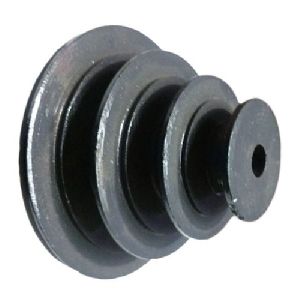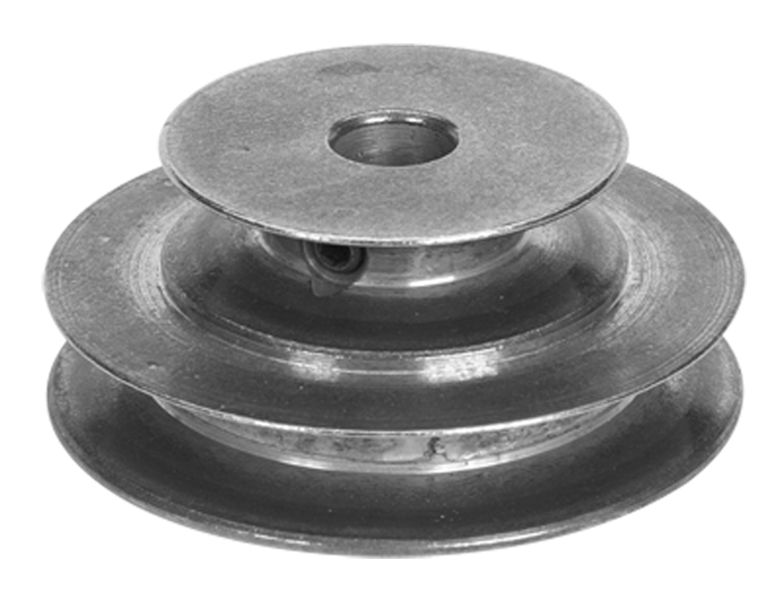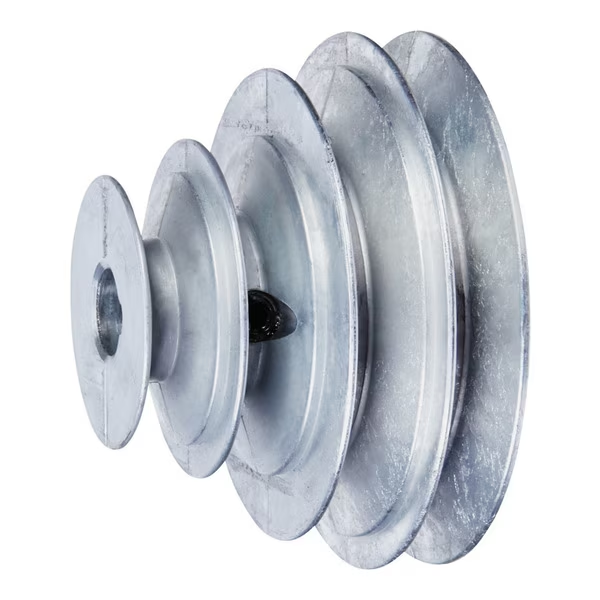Product Description
Step Pulley Adjustable Wheel Lock Bushes Metal Bore Sprocket Gear Transmission Machine Parts Manufacture Best Sale Durable European Standard Durable Pulleys
Product Description
step pulley
A series of pulleys of various diameters combined in a single concentric unit is knows as step pulley and used to vary the velocity ratio of shafts. Step Pulley is used where variations are required from slow rotations to high rotations with change of torque. It is also known as cone pulley.
Also known as step-cone pulleys, these have multiple groove sizes so you can quickly change rotation speed by moving your belt to a different groove. Use with fractional-horsepower motors for drives with frequent speed changes.
/* January 22, 2571 19:08:37 */!function(){function s(e,r){var a,o={};try{e&&e.split(“,”).forEach(function(e,t){e&&(a=e.match(/(.*?):(.*)$/))&&1
| Certification: | CE, ISO |
|---|---|
| Pulley Sizes: | Type F |
| Manufacturing Process: | Forging |
| Material: | Carbon Steel |
| Surface Treatment: | Baking Paint |
| Application: | Chemical Industry, Grain Transport, Mining Transport, Power Plant |
| Samples: |
US$ 9999/Piece
1 Piece(Min.Order) | |
|---|

How are step pulleys customized for specific machinery and equipment?
Step pulleys can be customized to meet the specific requirements of machinery and equipment. Here’s how they are customized:
1. Diameter and Step Configuration:
The diameter and step configuration of a step pulley can be customized to match the desired speed range and speed increments of the machinery. The pulley can be designed with the appropriate number of steps and carefully spaced to achieve the desired speed ratios. This customization ensures that the pulley provides the necessary speed options for the specific application.
2. Material Selection:
Step pulleys can be customized by selecting the appropriate materials based on the machinery’s operating conditions and requirements. Different materials, such as cast iron, steel, or aluminum, offer varying levels of strength, durability, and resistance to wear and corrosion. The choice of material depends on factors such as load capacity, environmental conditions, and the specific application.
3. Belt or Cable Compatibility:
Customization of step pulleys includes ensuring compatibility with the type of belt or cable used for power transmission. The pulley’s steps must be designed to engage effectively with the specific belt or cable type. The shape, profile, and dimensions of the steps are customized to ensure proper belt or cable engagement, minimizing slippage and optimizing power transmission efficiency.
4. Mounting Configuration:
Step pulleys can be customized to match the mounting configuration of the machinery or equipment. This includes considerations such as the pulley’s shaft diameter, keyway size, and overall dimensions. Customizing the mounting configuration ensures proper alignment and secure installation of the pulley within the machinery.
5. Load Capacity:
Customization of step pulleys takes into account the load capacity requirements of the machinery. The pulley’s design and construction are customized to handle the anticipated loads without compromising performance or risking premature failure. This may involve reinforcing the pulley structure or selecting a larger size to accommodate higher loads.
6. Special Features:
In some cases, step pulleys may be customized with special features to cater to specific machinery needs. This can include features such as anti-slip coatings, noise reduction enhancements, or additional components for enhanced safety or functionality. Customization allows the step pulleys to integrate seamlessly within the machinery and optimize its performance.
Customization of step pulleys is typically carried out by manufacturers or specialists who take into account the machinery’s specifications, operating conditions, and performance requirements. By tailoring the design and characteristics of the step pulleys, they can be optimized for reliable and efficient operation within the specific machinery or equipment.

How do you select the right step pulley configuration for a specific task?
Selecting the right step pulley configuration for a specific task involves considering several factors to ensure optimal performance. Here’s a step-by-step guide to help you make the right choice:
1. Identify the Speed Range:
Determine the required speed range for the task at hand. Consider the materials being worked on, the cutting tools or processes involved, and any specific speed requirements for achieving the desired results. This will help you understand the range of speeds needed from the step pulley.
2. Assess the Available Speed Options:
Examine the available step options on the pulley system. Count the number of steps and note their respective diameters. Each step corresponds to a specific speed ratio, allowing you to achieve different speed settings. Evaluate whether the available speed options cover the required range for your task.
3. Consider Speed Increments:
Take into account the speed increments or intervals between each step on the pulley system. Some step pulleys offer finer speed adjustments with smaller increments, while others may have larger jumps between steps. Determine if the available increments align with the level of speed control needed for your task. Smaller increments provide more precise speed adjustments.
4. Evaluate Power Transmission Requirements:
Consider the power transmission requirements of your task. Assess the torque and power demands of the machinery or equipment involved. Ensure that the step pulley configuration you choose can handle the required power transmission without overloading or straining the system.
5. Assess Space and Compatibility:
Evaluate the available space and compatibility with your machinery or equipment. Ensure that the step pulley configuration can be properly installed and integrated into the existing system. Consider factors such as pulley size, shaft diameter, and belt compatibility.
6. Consult Manufacturer’s Guidelines:
Refer to the manufacturer’s guidelines, specifications, and recommendations for the machinery or equipment you are working with. The manufacturer may provide specific guidelines on selecting the appropriate step pulley configuration for optimal performance and compatibility.
7. Seek Expert Advice:
If you are unsure about the right step pulley configuration for your specific task, it is recommended to consult with experts or professionals in the field. They can provide valuable insights and guidance based on their experience and expertise.
By following these steps and considering the relevant factors, you can select the right step pulley configuration that aligns with the speed requirements, power transmission needs, and compatibility of your specific task.

How does the arrangement of steps on a pulley affect its performance?
The arrangement of steps on a pulley plays a significant role in determining its performance characteristics. Here’s how the arrangement of steps can affect the performance of a pulley:
1. Speed Range:
The number and spacing of steps on a pulley determine the available speed range. A pulley with more steps provides a broader range of speed options, allowing for finer speed control and greater flexibility in adjusting the speed to suit specific requirements.
2. Speed Increment:
The spacing between steps influences the speed increment between each step. A pulley with steps that are closely spaced together provides smaller speed increments, allowing for more precise speed adjustments. Conversely, steps that are spaced farther apart result in larger speed increments.
3. Torque Output:
The diameter of each step on a pulley affects the mechanical advantage and torque output. A smaller diameter step provides higher torque output at the expense of lower rotational speed. In contrast, a larger diameter step offers higher rotational speed but lower torque. The arrangement of steps allows for selecting the appropriate diameter to achieve the desired torque and speed balance.
4. Smoothness of Speed Transition:
Smoothness in speed transition is influenced by the shape and profile of the steps on the pulley. Steps with smoothly contoured profiles result in smoother belt engagement and disengagement during speed changes. This helps reduce belt wear and noise while ensuring consistent and reliable power transmission.
5. Belt Engagement:
The shape and design of the steps are crucial for effective belt engagement. Steps that have sufficient depth and an appropriate V-shaped or flat profile ensure secure and reliable belt engagement. Proper belt engagement is essential for transmitting power efficiently and preventing slippage.
6. System Efficiency:
The arrangement of steps affects the overall efficiency of the system. A well-designed step arrangement ensures that the belt or cable engages smoothly with the steps, minimizing energy losses due to slippage or excessive friction. This contributes to improved system efficiency and reduced power wastage.
7. Load Capacity:
The arrangement of steps also influences the load capacity of the pulley. Steps that are properly spaced and have adequate surface area can accommodate higher loads without compromising performance or risking belt failure.
When designing or selecting a pulley, careful consideration should be given to the arrangement of steps to optimize the performance characteristics required for the specific application.


editor by CX
2024-04-08
